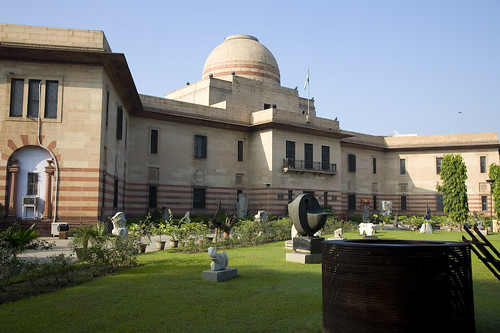Ten Lesser Known Places to Visit in Delhi This Winter
It is that time of the year again when the pullovers, shawls and trendy jackets come out in full flair, as people flaunt their stuff across the national capital of Delhi. People love to sit out and bask in the sun, and weekends can see popular destinations dotted by people across the city, like India Gate, Qutb Minar, Gurdwara Bangla Sahib, Akshardham and Humayun’s tomb among other perennial shopping destinations like Chandni Chowk. But step aside from these popular jaunts, there are innumerable sites that few know about, and tend to be free of the crowds that throng the otherwise popular places.
Being the only preserved haveli or old bungalow in Chandni Chowk, Old Delhi, it belonged to Lala Chunnamal, a Khatri businessman who went on to become the richest man in Delhi and whose wealth was envied even by the likes of Mirza Ghalib. Do check it out for its beautiful architecture and lavish interiors, that take you back in time, thanks to the descendants of Lala Chunnamal who still live in the building.
A quaint home for biologically rich wetlands, grassland communities, a wide variety of fruit yielding species and an abundance of medicinal herbs, it is the last preserve for flora and fauna native to the Gangetic basin in and around the national capital of Delhi, many of which were not seen for more than a century. The Yamuna Biodiversity Park is presently spread over an area of approximately 457 acres near Wazirabad village, and is a refreshing break from the noise and chaos of Delhi as an ideal picnic spot.
Believed to have been built in the twelth century by the legendary Tomar Rajput Prithviraj Chauhan, Rai Pithora, also known as Lal Kot, is the oldest surviving remains that chronicle the city of Delhi. The adjoining area was spruced up into a well maintained garden, and you can stroll through the ruins of the fort. You can soak the sun in plenty, while photography enthusiasts can capture a glorious sunset with great pleasure.
The last grand Mughal structure to be built in Delhi, it is named after the Mughal governor and later vizier (Chief minister) of the Mughal emperor Safdarjung. Marking the subsequent decline of the Mughals, it is made of sandstone much like a smaller version of Humayun’s tomb, only that it has a brown shade. The beautiful tomb is surrounded by the traditional Mughal char-bagh (four gardens), and is home to an innumerable number of Rose ringed Parakeet, who make up for the lack of noise that this place often has.
One of the seven cities of Delhi, it was set up by the Tughlaq ruler, Feroz Shah, in the fourteenth century and lies across the road to Rajghat, the crematorium cum memorial of Mahatma Gandhi. A particular but rarely noticed attraction here is an Asokan edict that was moved by Feroz Shah from then Punjab to the tomb, making it the second such edict present in Delhi. Flanked by a garden on one side and the entrance being close to the cricket stadium by the same name, the place has in recent times also become a haunt for several faithful who ask djinns for favours.
Close to the Tughlaqbad institutional cum residential area are ruins of a city that sprawls over six kilometers. Founded by the dynasty founder Ghiyas-ud-din Tughlaq, it was abandoned by Mohammad Bin Tughlaq for the disastrous experiment of Daulatabad soon. Legend has it that the Sufi saint Nizamuddin Auliya had cursed Ghiyas-ud-din that his city would only be occupied by Gujjars, who still live there today.
Located on the Southern Ridge, the extension of Aravalli Hills into Delhi, the community land of villages Asola, Shapur, Maidangari, and Bhatti were notified in 1991 as a Sanctuary by Delhi administration. This place is home to several species such as Nilgai, chinkara, porcupines and even Jungle Cat, while being a haven for birdwatchers and lepidopterologists alike especially in winters.
Two religious places that also signify the communal amity of Delhi, Yogmaya and Qutbuddin’s Dargah are both located in Mehrauli. Yogmaya is an ancient temple where Krishna’s sister who Kamsa had unsuccessfully tried to kill in jail after substitution. The temple dates back to the times of King Hemu, who eventually made way for Akbar’s ascendance to the throne of Delhi. This is the only temple in Delhi to survive Aurangzeb’s onslaught. Around the same time as Akbar, Qutbuddin Bakhtiyar Kaki, Sufi saint of the Chisti order, came to India and made his base, making it one of the three key centers of Sufi belief in Delhi which is important for Sufis across South Asia. The two are related to each other with a unique festival in October called Phoolwalon ki Sair that signifies the communal harmony between Hindus and Muslims of Mehrauli, and is now Delhi’s official festival.
One of the finest but less discussed places is this gallery that showcases the evolution of modern art in India. It houses some of the rare paintings by the Tagore family, Jamini Roy, Souza, Raza, Hussain and Gaitonde amongst the other Indian masters, and is an oasis of calm in the midst of the anarchic traffic that surrounds India Gate perennially. A must visit for art aficionados and others alike. Of course, pictures are not allowed.
This is a recent addition to Delhi, and is a tribute to Martyrdom of Guru Teg Bahadur, the ninth Guru of the Sikhs, who had given up his life against the tyranny of Mughal Emperor Aurangzeb. The memorial is intended to provide and insight into the life and teachings of the ninth Guru and about Sikhism in general. The place also has a beautiful sound and light show every evening in Hindi English and Punjabi between 6 and 8 p.m.



Comments